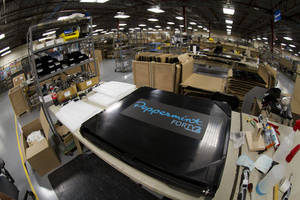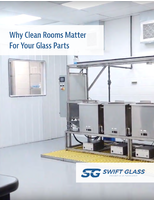Stratasys 3D Printers Help Energize Developing Regions Around the World

Companies using FDM 3D printing technology to create innovative energy solutions that aid those without reliable electricity
Minneapolis, Minn.; Rehovot, Israel – Additive manufacturing using 3D printing technology has the potential to compress supply chains, minimize materials and energy use, and reduce waste, according to the U.S. Department of Energy. But beyond streamlining production processes, companies are also using 3D printers to bring innovative, low-cost energy solutions to the market itself – including portable solar arrays and bicycle-powered generators.
Organizations such as Peppermint Energy and Designs For Hope have used 3D printing technology from 3D printer manufacturer Stratasys (NASDAQ: SSYS) to help individuals spur economic development, participate in emerging industries, and access educational opportunities in areas of the world that don't have reliable access to electricity.
Worldwide, 1.3 billion people lack access to electricity, according to the International Energy Agency. South Dakota-based Peppermint Energy is determined to change that with its flagship product called the FORTY2. Like a solar plant in a suitcase, the FORTY2 is a portable array that draws enough energy from the sun to provide light, refrigerate medicine or food, or power a laptop. A battery connected to the array stores power for use when the sun is down.
For real-world design testing of the FORTY2, Peppermint Energy's development team used Stratasys 3D printing technology to 3D print functional prototypes. At three feet wide and roughly 60 pounds, the FORTY2 required a robust housing strong enough to hold all of its components. The first full-scale prototype, built in a Stratasys Fortus® 3D Production System, revealed some of the design considerations that led to the FORTY2's simple operation.
In response to the devastating Haiti earthquake in 2010, the FORTY2 was developed to bring emergency power to the area, and is being used in the rebuilding efforts, as shown in this video.
"It's only when you see it in physical form that you realize the form and function should be the same," said Peppermint Energy co-founder Brian Gramm. Using Stratasys FDM 3D printing technology, the team was able to quickly make modifications, allowing for fast improvements and saving an estimated $250,000 in tooling costs. For example, a power switch is unnecessary; just opening the FORTY2 turns it on. The Peppermint team also decided to make the whole device even smaller than intended after carrying the first prototype proved awkward.
Another company, Designs For Hope in Alabama, has developed an inexpensive, durable device that enables rotational energy to be harvested and stored from one of the simplest and most readily available forms of transportation in developing regions worldwide, a bicycle. The device holds a generator on a bike, harvests its power and conditions the electricity for storage in a battery.
The development team began making prototypes on a Dimension 3D Printer from Stratasys, but the initial design had some flaws. After the team 3D printed out its first idea and held it next to a bicycle, they realized it wouldn't work, said Chris Bond, founder of Designs for Hope. After many design iterations and prototypes, made possible using the Dimension 3D Printer, the team finalized the device, and has since worked with missionary networks to place units in the field.
One recipient is a Uganda orphanage whose only power comes from a small solar-panel system. Orphanage workers commute seven to ten kilometers daily by bike. Once at work, they charge their cell phones from the solar panels, gobbling up limited power. Bond hopes his device alleviates this problem.
"The beautiful thing is, they're using their bikes anyway," says Bond. "It's free energy."
Stratasys Ltd. (Nasdaq: SSYS), headquartered in Minneapolis, Minn. and Rehovot, Israel, manufactures 3D printers and materials for prototyping and production. The company's patented FDM® and PolyJet™ 3D Printing technologies produce prototypes and manufactured goods directly from 3D CAD files or other 3D content. Systems include 3D printers for idea development, prototyping and direct digital manufacturing. Stratasys subsidiaries include MakerBot and Solidscape, and the company operates the RedEye digital-manufacturing service. Stratasys has more than 1700 employees, holds over 500 granted or pending additive manufacturing patents globally, and has received more than 20 awards for its technology and leadership. Online at: www.stratasys.com or http://blog.stratasys.com
FDM, Stratasys, Objet and Fortus are registered trademarks, and Fused Deposition Modeling, PolyJet and Dimension are trademarks of Stratasys Ltd. and or its subsidiaries or affiliates.
Attention Editors, if you publish reader-contact information, please use:
• USA 1-877-489-9449
• Europe/Middle East/Africa +49-7229-7772-0
• Asia Pacific +852 39448888
Stratasys Media Contacts
Stratasys
Arita Mattsoff / Joe Hiemenz
Stratasys
Tel. +972-(0)74-745-4000 (IL)
Tel. +1-952-906-2726 (US)
arita@stratasys.com
joe.hiemenz@stratasys.com
Asia Pacific
Stratasys AP
Janice Lai / Vicki Kei
Tel. +852 3944 8818
Janice.lai@stratasys.com
Vicki.kei@stratasys.com
Japan
Stratasys Japan
Aya Yoshizawa
Tel. +81 90 6473 1812
Aya.yoshizawa@stratasys.com
Korea
Stratasys AP
Jihyun Lee
Tel. +82-10-3408-1609
jihyun.lee@Stratasys.com
Brazil




